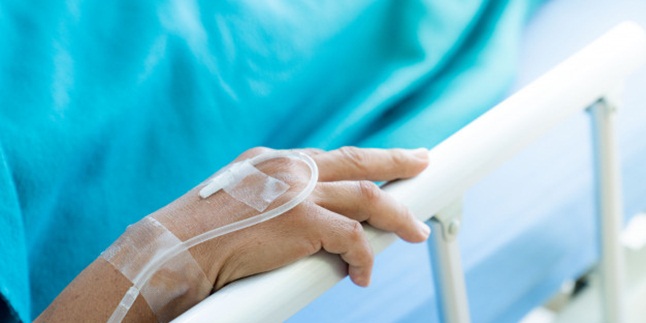The Law and Procedure of Kusuf Prayer Performed During a Solar Eclipse
Straight to the point, here are the laws and procedures of kusuf prayer performed during a solar eclipse.

Kapanlagi.com - In a sick condition, Muslims are still required to perform prayers because prayer is an obligation that is pursued to seek the pleasure of Allah SWT. Therefore, the procedure for praying sitting also needs to be known by Muslims. Of course, you always pray to be blessed with good health, but the thing is, you never know when illness will strike.
By knowing the procedure for praying while sitting, you will also realize how Islam provides ease for its followers in carrying out the commandments. The explanation regarding this matter can be seen in the words of Allah SWT in Surah Al-Baqarah verse 286 as follows,
"Allah does not burden a person beyond his capacity."
There is also an explanation regarding the procedure for praying while sitting according to the guidance of Prophet Muhammad SAW as follows,
"It was narrated from Ibn Buraidah, from Imran bin Hushain RA, he said, 'I suffered from hemorrhoids, so I asked the Prophet (SAW) about praying (in a sick condition), then he replied, 'Pray standing, if you are unable, then sitting, and if you are unable, then lying down on your side,'" (Narrated by Al-Bukhari in Jamius Shahih Bukhari, [Cairo, Mathba'ah Al-Amiriyyah: 1286 H], 4/377).
Well, to find out the procedure for praying while sitting along with the explanations, let's directly refer to the information compiled from various sources below.

Illustration (Credit: Freepik)
Allah SWT has said that He will not burden anyone beyond their ability, which means that Allah will always give opportunities to His servants when they want to draw closer to Him. Prayer remains obligatory as long as one is conscious and healthy, so someone who is unable to perform it properly does not mean they are allowed to abandon prayer. Therefore, there are provisions or procedures for sitting prayer for those who are sick.
Based on information from nu.or.id, the fuqaha (scholars of Islamic jurisprudence) have formulated detailed procedures for sitting prayer. Anyone who prays in a sitting position must follow the formulation of the expert scholars of jurisprudence so that our worship is guided by them.
The limitations of ability based on the procedures for sitting prayer are based on masyaqqat syadidah (severe difficulties) that are felt, which are difficulties that generally someone cannot bear or endure, even though the difficulty has not reached the limit of permissibility for performing tayammum. Regarding masyaqqat syadidah, scholars have different opinions:
1. According to Ibn Hajar, it is not just a difficulty that disrupts concentration, but it must be more than that.
2. According to Muhammad Ramli, it is a difficulty that has already disrupted concentration.
3. According to As-Syarqawi, masyaqqat is a difficulty that eliminates perfect khusyuk.
"Then, if someone is unable to stand with a representation until severe difficulty or obvious difficulty arises - two different expressions but with the same meaning - which is a difficulty that generally cannot be endured even though it does not allow -uzur- to perform tayamum such as feeling dizzy (kliyeng-kliyeng, mumet). Is the meaning of masyaqqat syadidah that it eliminates khusyuk? Ibnu Hajar said, 'no', Muhammad Ramli said, 'yes', and even As-Syarqawi said, a difficulty that eliminates perfect khusyu, so someone is allowed to pray sitting in any way he wants and it does not reduce the reward of standing," (Busyra al-Karim bi Syarh Masail al-Ta'lim, page 200).
As for khusyuk, it has various definitions, including as explained below:
"Khusyuk in prayer is to focus attention, turn away from other than Allah, and contemplate on what is recited by the tongue, both readings (Al-Quran) and remembrance," (Al-Husain bin Mas'ud Al-Baghowi, Tafsir Al-Baghowi, [Dar Thaibah, 1417 H/1997 M], volume V, page 409).
Scholars do not provide guidelines regarding the sitting position as a substitute for the pillar of standing, so someone is allowed to sit on a chair, but the main thing is to sit iftirasy (sit as in the first tashahhud). It must be understood that sitting is a substitute for the pillar of standing, so the sitting position can only be done when one truly feels difficulty if praying in a standing position.

Illustration (Credit: Freepik)
Purification is one of the requirements for valid prayer, which means it must still be done by Muslims who want to worship even when they are sick. Performing prayer by following the procedure for sitting prayer also means following the procedure for purification for the sick as follows.
1. It is obligatory for a sick person to take a bath, as a form of cleansing oneself from major impurities, then perform ablution to remove minor impurities.
2. If unable to use water for ablution due to certain obstacles or concerns that the illness will worsen, then tayammum is allowed.
3. Procedure for tayammum: recite the intention for tayammum, then tap both hands on a clean surface. Then wipe the face and tap both hands again to wipe the hands.
4. If a sick person is unable to perform tayammum and ablution, they can be assisted by someone else. Someone who taps and wipes on the sick person. The same goes for performing ablution.
5. If a sick person has a wound or is in a cast, then wiping with water once is sufficient as a substitute for washing.
6. Make sure the sick person wears clean clothes when performing prayer. Not contaminated with impurities or dirt that can invalidate the prayer. If not possible, then pray as best as one can.
7. Also pray in a clean place, if there is impurity it is advisable to replace or clean it. A clean cloth can also be spread as a prayer mat.

Illustration (Credit: Freepik)
It is better to pray on time, because it has been made easier with ablution replaced by tayammum and lighter prayer movements. Next, please refer to the sitting prayer procedure as reported by merdeka.com below.
Sitting Prayer Position
1. If unable to stand, it is allowed to perform the prayer while sitting facing the qibla. You can sit like sitting between two prostrations or sit with straightened legs. Depending on the illness suffered.
2. The way to perform the bowing movement is by sitting slightly bent. Hand movements are the same as regular prayers.
3. The way to perform prostration is the same as regular prostration. Except for those who pray with straightened legs, the bowing movement is slightly less than the bowing in prostration.
It has been said that the sick person is given leniency in performing worship. If a sick Muslim is unable to follow the sitting prayer procedure, they can pray in a lying position.
Lying Prayer Position
1. If a sick person cannot perform the prayer while sitting, they are allowed to perform it in a lying position facing the qibla, with a higher pillow position.
2. The way to perform the bowing movement is simply by moving the head forward or slightly bending.
3. The way to perform prostration is by moving the head further down or more inclined. If there is an illness that hinders these two movements, such as a neck in a cast. Sick people can communicate by opening and closing their eyes instead of making movements.
4. The sleeping position can also be lying on the right side or towards the qibla. The movements of ruku and sujud are the same.
5. If all the above methods are not possible at all, sick people can perform prayers in their hearts, as long as their mind and soul are still intact.
If the sick person finds it difficult to do so, it is also allowed to combine prayers using jama taqdim. For example, combining Dhuhr and Asr prayers at the time of the Dhuhr adhan.
Furthermore, for sick people who are receiving treatment abroad, it is also allowed to perform shortened prayers (qashar). So they can perform Dhuhr, Asr, and Isha prayers with only 2 rak'ahs.
That is the explanation of the procedure for sitting prayers for sick people. Hopefully, it can enlighten and strengthen your hearts to continue to strive to get closer to Allah SWT even in a state of illness.
(kpl/ans)
Cobain For You Page (FYP) Yang kamu suka ada di sini,
lihat isinya
Straight to the point, here are the laws and procedures of kusuf prayer performed during a solar eclipse.
Mud cake recipes are also diverse. This means that mud cakes can be made not only in standard form like those sold in the market. More than that, we can create unique and addictive mud cake creations.
Not only a dish in restaurants, with tomyam recipe we can make and enjoy it directly at home.
This is a practical, delicious, and spicy shredded chicken recipe for the family's breaking the fast dish.
Here are 7 benefits of praying in Ramadan, which is a very mustazab time. Let's check it out, KLovers.
These are 6 Lebaran traditions that have changed during the Covid-19 pandemic. What are they? Let's check it out KLovers.
Just go ahead, check out the savory vegetable fritters recipe, cheap homemade fried food
Here are 60 wise Islamic words of comfort, which can be good advice for life. Let's check it out KLovers.
When posting a selfie photo, writing a caption for yourself as a complement to the photo can be quite difficult. Because, writing a message for yourself is not as easy as writing a message for others.
Currently, we can easily find rawon, from food stalls to restaurants. However, with a special rawon recipe, we can make rawon with a special homey taste.
Cooking grilled fish recipes at home can be a fun activity with your family. Especially after it's cooked, you can enjoy it with your family. Accompanied by white rice, sambal, and fresh vegetables, grilled fish can be a delicious and special dish to enjoy with your family.
Here are 6 easy and delicious fish curry recipes that are not fishy. Let's check it out KLovers.